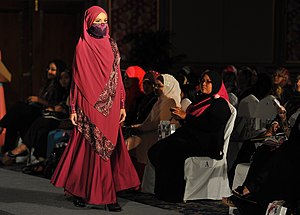
Islamic Fashion as a phenomenon stemmed from the combination of a set of Islamic practices (in which the need to cover a specific set of body parts is present) and of the rising need and desire to include these specific clothing items in a broader fashion industry. The global growth of “an Islamic consumer sector, which explicitly forges links between religiosity and fashion, encouraging Muslims to be both covered and fashionable, modest and beautiful,” is relatively fresh: Islamic Fashion as a particular phenomenon started appearing toward the 1980s.[1]
The most recent developments in the field have caused a varied public discourse on a series of different levels, from the political, to the religious, to the cultural. Different positions are taken by different participants in the discussion of the politics and cultures of Islamic fashion.
Islamic Fashion market nowadays presents the rapidly expanding niche that is still relatively empty in a global scale. Big brands are trying to present their collections related to Muslim religious observances, however, without any visible attempts to single-handedly secure the Muslim customers in Western countries leaving the space for the emerging young designers mainly from Muslim states. In the United Arab Emirates, particularly Dubai, are steadily laying the ground to become the Islamic Fashion center with a highly curated Designers District and housing of the leading Islamic brands.
- ^ Tarlo E. Hijab in London: Metamorphosis, Resonance and Effects. Journal of Material Culture. Vol. 12(2): 138
© MMXXIII Rich X Search. We shall prevail. All rights reserved. Rich X Search
